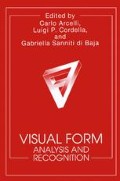Abstract
The skeleton is a useful tool for analyzing the shape of a non trivial planar figure, namely a connected set of pixels which has variable width and protrusions of different size. The skeleton is a connected subset of the figure, centrally placed in it and with the same connectivity order. Its pixels are labeled with their distance from the complement of the figure, and its branches are located in correspondence with the protrusions regarded as significant in the problem domain. To facilitate both figure interpretation and further processing, the skeleton is generally required to be a linear set, i.e., to be the union of simple digital arcs and curves where no pixel can be removed without creating disconnection or shortening.
Access this chapter
Tax calculation will be finalised at checkout
Purchases are for personal use only
Preview
Unable to display preview. Download preview PDF.
References
C.J. Hilditch, “Linear skeletons from square cupboards”, in Machine Intelligence 4, B. Meltzer and D. Michie Eds., Edinburgh University Press, pp. 403-420, 1969.
G. Borgefors, “Distance transformations in digital images”, CVGIP, 34, pp. 344–371, 1986.
L. Dorst, “Pseudo-Euclidean skeletons”, Proc. 8th ICPR, Paris, pp. 286-288, 1986.
B.J.H. Verwer, “Improved metrics in image processing applied to the Hilditch skeleton”, Proc. 9th ICPR, Rome, pp. 137-142, 1988.
S. Yokoi, J.I. Toriwaki, and T. Fukumura, “An analysis of topological properties of digitized binary pictures using local features”, CGIP, 4, pp. 63–73, 1975.
D. Rutovitz, “Pattern Recognition”, J. Roy. Statist. Soc., 129, pp. 504–530, 1966.
Author information
Authors and Affiliations
Editor information
Editors and Affiliations
Rights and permissions
Copyright information
© 1992 Springer Science+Business Media New York
About this chapter
Cite this chapter
Arcelli, C., Frucci, M. (1992). Reversible Skeletonization by (5,7,11)-Erosion. In: Arcelli, C., Cordella, L.P., di Baja, G.S. (eds) Visual Form. Springer, Boston, MA. https://doi.org/10.1007/978-1-4899-0715-8_3
Download citation
DOI: https://doi.org/10.1007/978-1-4899-0715-8_3
Publisher Name: Springer, Boston, MA
Print ISBN: 978-1-4899-0717-2
Online ISBN: 978-1-4899-0715-8
eBook Packages: Springer Book Archive

